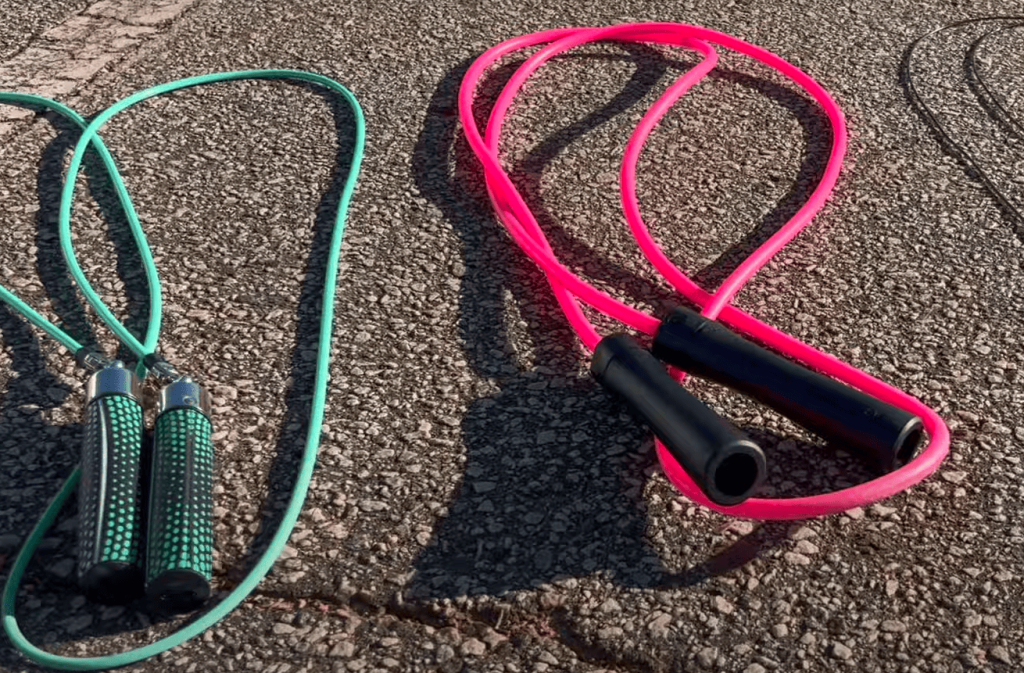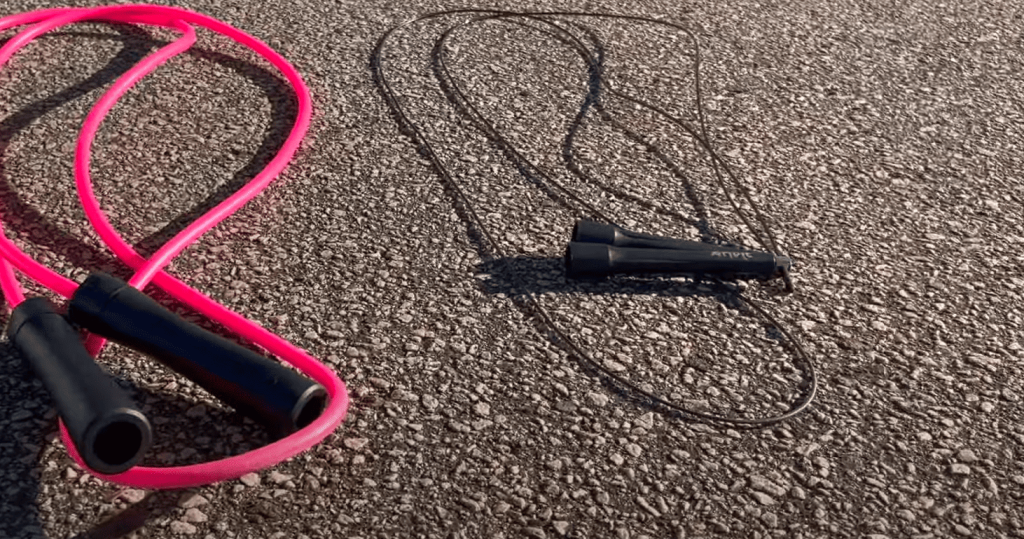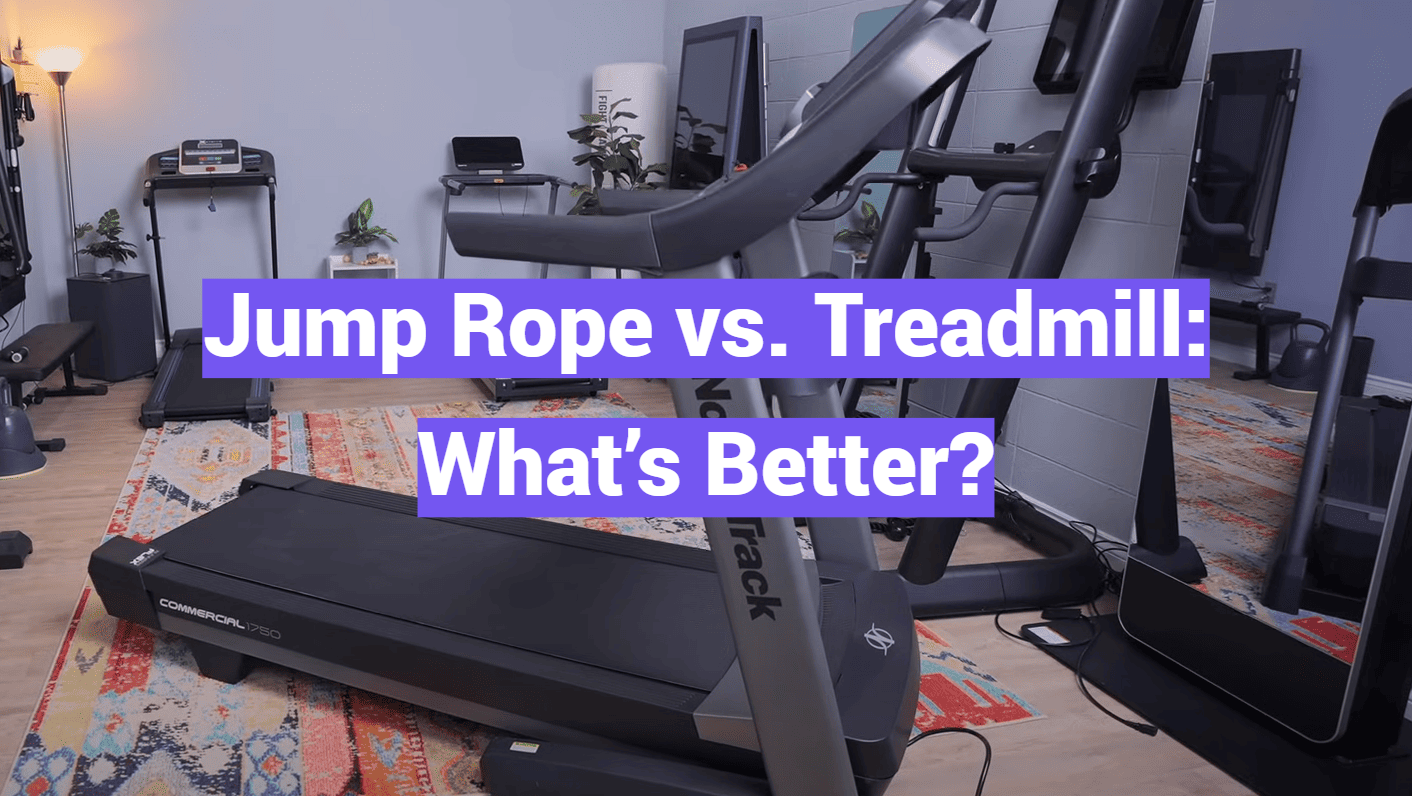Surprised? Studies show high-intensity cardio like skipping can torch up to 1,300 calories per hour – nearly triple what steady-paced jogging achieves. This sparks a critical question for time-crunched Americans: which exercise truly delivers better results for your fitness goals?
For decades, people have debated whether portable, affordable tools or gym machines reign supreme. Both options require minimal gear and adapt to busy schedules, but their differences matter. Compact routines fit apartment living, while indoor running suits predictable weather – though costs and space needs vary wildly.
We’ll break down the science behind calorie burn, joint stress, and long-term effectiveness. You’ll discover how each workout aligns with weight loss, heart health, or athletic training. No guesswork – just clear comparisons of effort, impact, and real-world practicality.
Key Takeaways
- High-intensity sessions often outperform steady cardio for calorie burn
- Space and budget limitations influence which option works best
- Joint health considerations vary significantly between activities
- Both methods can complement modern training programs
- Personal preferences determine long-term consistency
Introduction to Cardio Workouts
Building a strong fitness routine starts with understanding cardio’s role in overall health. Whether you’re aiming to boost energy or reduce health risks, these exercises form the backbone of lasting wellness.

Overview of Cardio Benefits
Regular cardio strengthens your heart, lowers blood pressure, and improves oxygen flow. Studies show it also sharpens mental focus and reduces stress hormones like cortisol. Even 30 minutes daily can enhance sleep quality and mood.
Mixing aerobic and anaerobic training keeps routines fresh. Steady-paced activities build endurance, while bursts of intensity torch calories faster. This combo prevents plateaus and keeps your body adapting.
| Activity Type | Primary Benefit | Ideal For |
|---|---|---|
| Aerobic (e.g., jogging) | Improves lung capacity | Long-term stamina |
| Anaerobic (e.g., sprints) | Boosts power output | Quick energy bursts |
Setting Your Fitness Goals
Start by asking: “Do I want weight loss, better athletic performance, or general health?” Your answer shapes which exercises fit best. A busy parent might prefer short, intense sessions, while a marathon trainee needs endurance drills.
Consider your schedule, space, and physical limits. Enjoyment matters most – if you hate an activity, you won’t stick with it. Choose options that align with your lifestyle for lasting results.
Jump Rope vs Treadmill: Understanding the Basics
Selecting the right cardio tool involves more than personal preference—it’s about matching your environment and resources. Let’s explore what each option demands before you commit.
Gear Essentials and Movement Styles
A rhythmic activity using a rotating cord develops coordination through precise timing. This method requires only a durable rope and supportive shoes, letting you start in minutes. In contrast, indoor running machines offer adjustable speeds and cushioned decks, prioritizing joint comfort during repetitive strides.
Budget and Lifestyle Factors
Affordable fitness solutions shine here. Quality cords range from basic $10 models to premium $100 versions with weighted handles. Compare this to mechanical runners requiring hundreds upfront, plus ongoing maintenance fees.
| Factor | Portable Option | Stationary Machine |
|---|---|---|
| Setup Area | 6×6 ft clearance | Dedicated floor space |
| Travel-Friendly | Fits in backpacks | Permanent installation |
| Upkeep | None | Lubrication, repairs |
Urban dwellers and frequent travelers benefit most from compact gear. Those with home gyms might prefer customizable machines despite higher costs. Your space availability and workout frequency ultimately guide this decision.
Calorie Burn and Intensity: Jumping Compared to Running
Energy expenditure separates casual workouts from game-changing routines. Let’s crunch numbers to see how different intensity levels stack up.
Comparative Calorie Estimates
A 150-pound person burns:
| Intensity | Activity | Calories/10 Minutes |
|---|---|---|
| Low | Skipping | 105 |
| Low | Steady-paced strides | 117 |
| Medium | Cord-based workouts | 140 |
| Medium | Indoor jogging | 125 |
“Heavy training cords torch 13.6 calories per minute – outperforming most steady cardio options.”
| Rope Type | Calories/Minute |
|---|---|
| Weighted handles | 13.6 |
| Beaded | 13.4 |
| Speed | 13.2 |
Intensity and Heart Rate Dynamics
Both activities spike heart rate, but rhythmic motions create faster surges. This makes skipping ideal for 20-second HIIT bursts followed by brief recovery.
Advanced techniques match running a 7-minute mile (12.3 METs). Your body works harder coordinating movements while maintaining pace – doubling the cognitive challenge.

Impact on the Body and Joint Considerations
Your workout’s physical demands shape both results and risks. Let’s explore how different exercises affect muscle development and joint health – crucial factors for sustainable fitness progress.
Muscle Engagement and Core Stabilization
Both activities activate calves, quads, and hamstrings for propulsion. The rhythmic motion requires constant core engagement to maintain balance, especially during lateral movements or speed variations.
| Activity | Primary Muscles Worked | Secondary Activation |
|---|---|---|
| Rhythmic Coordination | Shoulders, forearms | Obliques, lower back |
| Indoor Striding | Glutes, hip flexors | Minimal upper body |
“Proper technique reduces knee stress by 28% compared to poor form,” notes the 2019 Gait & Posture Journal study.
Knee Safety and Joint Stress
Ground contact forces measure similarly in both exercises, but surface choice changes everything. Cushioned machine decks absorb shock better than concrete, while proper footwear matters most for portable workouts.
Three techniques protect your knees:
- Land softly on balls of feet
- Maintain slight knee bend
- Avoid locking joints
Urban athletes often prefer low-impact alternatives like elliptical training. However, controlled movements on forgiving surfaces make rhythmic coordination surprisingly joint-friendly when mastered.
Techniques for Safe and Effective Workouts
Mastering movement mechanics transforms good intentions into lasting results. Whether you’re new to fitness or refining your routine, smart technique choices prevent injuries while boosting performance.
Proper Form and Footwear Tips
For rhythmic coordination activities:
- Adjust cord length by stepping on the center – handles should reach armpits
- Keep hops under 2 inches, landing softly on forefoot cushions
- Engage core muscles to maintain upright posture
Indoor runners should:
- Set incline to 1-2% to mimic outdoor resistance
- Strike with midfoot instead of heel to reduce shock
- Keep shoulders relaxed and gaze forward
| Activity | Footwear Feature | Benefit |
|---|---|---|
| Cord Work | Shock-absorbing soles | Redces ankle strain |
| Machine Running | Arch support | Aligns stride |
Utilizing Cushioned Surfaces and Alternatives
Rubber mats or wooden floors offer better knee protection than concrete during high-impact sessions. Grass fields work for outdoor enthusiasts, though uneven terrain requires extra caution.
Modern exercise machines feature:
- Shock-absorbing decks that mimic track surfaces
- Emergency stop clips for sudden fatigue
- Pre-programmed warm-up routines
“Low-impact alternatives like aquatic exercises maintain intensity while eliminating 75% of joint stress,” suggests recent biomechanics research.
For those managing existing discomfort:
- Try rebounder mini-trampolines for gentler bouncing
- Gradually increase workout duration over 4-6 weeks
- Combine activities to distribute impact load
Benefits Beyond Calories: Endurance, Strength, and Full-Body Engagement
True fitness gains extend far beyond simple calorie counts. Rhythmic coordination drills offer unique advantages that traditional gym equipment often misses. These dynamic movements challenge your body and mind in ways that translate to real-world athleticism.

Building Multi-System Stamina
Sustained cord workouts engage both aerobic and anaerobic systems simultaneously. A 12-week study showed participants improved cardiovascular markers while reducing body fat by 4.7%. This dual-energy demand makes these sessions efficient for holistic conditioning.
“Athletes who mastered double-unders improved 40-yard dash times by 0.3 seconds,” reports the Journal of Sports Science & Medicine.
Three key areas benefit most:
- Coordination: Hand-eye timing sharpens reaction speeds
- Agility: Footwork patterns mimic sport-specific movements
- Power: Explosive repetitions build fast-twitch muscle fibers
| Skill Level | Endurance Benefit | Strength Gain |
|---|---|---|
| Beginner | +18% VO2 max | +9% grip strength |
| Advanced | +29% anaerobic capacity | +14% shoulder stability |
Busy schedules thrive on 15-minute sessions mixing steady pacing with skill drills. This approach delivers 87% of longer workouts’ benefits, according to HIIT research. The versatility keeps routines fresh while maximizing time efficiency.
Conclusion
Choosing between two powerful cardio methods comes down to your unique needs. Both activities torch calories efficiently and boost heart health, but each shines in different scenarios. The portable option requires minimal investment and space, making it ideal for travelers or apartment dwellers. Meanwhile, cushioned machines offer joint-friendly surfaces for those managing impact concerns.
Your goals and lifestyle dictate the better choice. Prefer full-body engagement and quick sessions? The rhythmic alternative delivers. Need controlled progression or weatherproof training? Indoor strides excel. Many people blend both into their routine for variety – mixing high-intensity bursts with steady endurance work.
Remember: the best exercise is the one you’ll do consistently. Whether you prioritize cost, convenience, or joint care, both options produce results when practiced regularly. Let personal enjoyment guide your decision, and watch your fitness transform.

